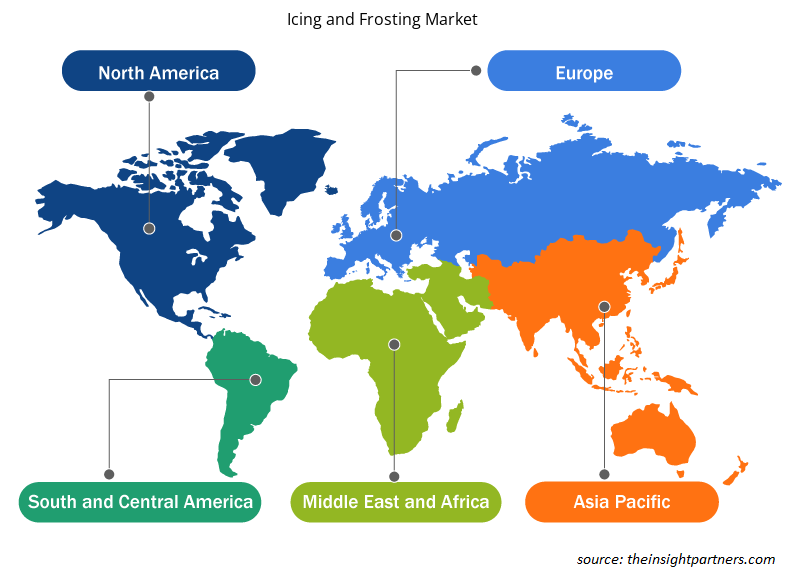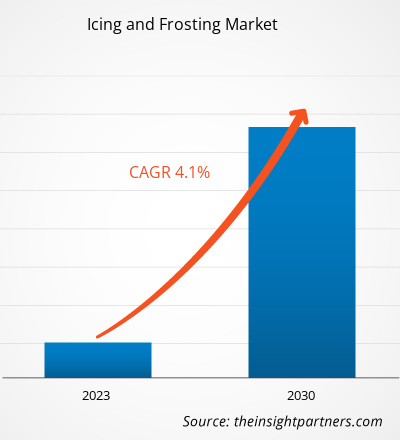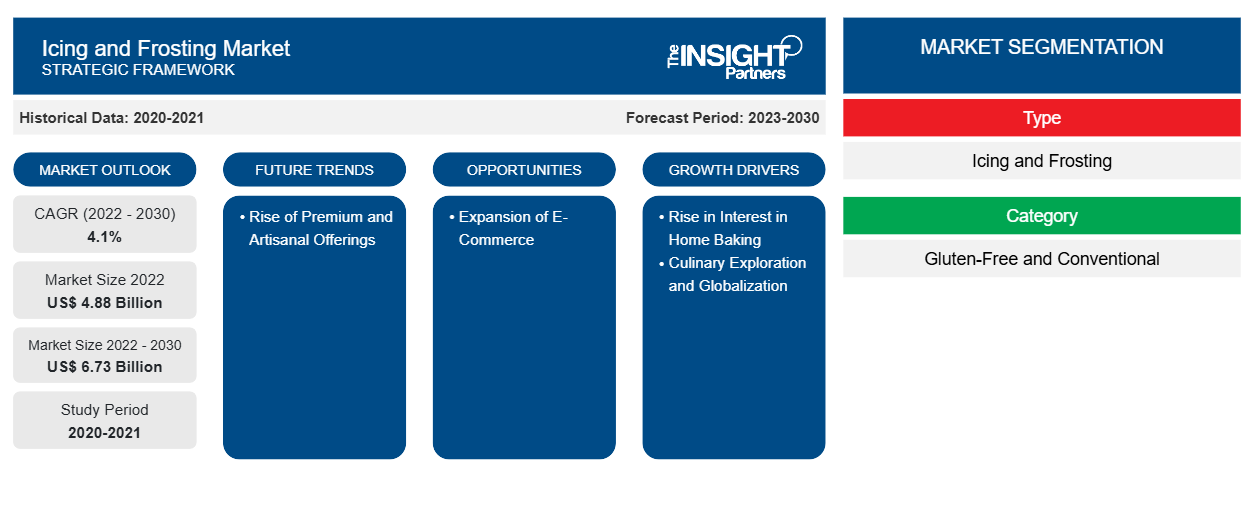[Rapporto di ricerca] Il mercato della glassa e della glassa è stato valutato a 4.883,15 milioni di dollari nel 2022 e si prevede che raggiungerà i 6.730,00 milioni di dollari entro il 2030; si stima che registrerà un CAGR del 4,1% nel periodo 2022-2030.
ANALISI DI MERCATO
La glassa e la glassatura sono un segmento dinamico degli ingredienti da forno nel settore della vendita al dettaglio, in quanto sono ampiamente utilizzati per decorare e aggiungere sapori a torte, pasticcini e altri prodotti da forno. Con una crescente base di consumatori globali interessati a prelibatezze e dessert speciali, il mercato della glassa e della glassatura ha assistito a una costante espansione alimentata da fattori quali l'urbanizzazione, il cambiamento degli stili di vita dei consumatori e la popolarità della cottura casalinga. La segmentazione del prodotto include opzioni tradizionali come crema al burro e glassa reale, insieme a innovazioni più recenti come fondente e glassa al formaggio cremoso, soddisfacendo un'ampia gamma di gusti e preferenze. I canali di distribuzione variano da supermercati, minimarket e panetterie specializzate a piattaforme di vendita al dettaglio online, riflettendo le diverse abitudini di acquisto dei consumatori.
Negli ultimi anni, c'è stata una crescente domanda di prodotti per glassa e glassa naturali e biologici, guidata da consumatori attenti alla salute che cercano ingredienti più puliti e trasparenti. Ciò ha portato allo sviluppo di prodotti realizzati con alternative vegetali, dolcificanti naturali come sciroppo d'acero o miele e glassa tradizionale a base di latticini. Inoltre, l'ascesa dei social media e dei programmi di pasticceria ha portato a un crescente desiderio di decorazioni uniche e visivamente accattivanti per i prodotti da forno. I consumatori cercano opzioni di glassa e glassa personalizzate e personalizzate, creando opportunità per aziende specializzate che offrono design creativi e stampe commestibili.
I principali fattori che contribuiscono alla crescita delle dimensioni del mercato delle glasse e delle glasse sono il crescente interesse per la pasticceria casalinga, l'esplorazione culinaria e la globalizzazione. L'esplorazione culinaria e la globalizzazione favoriscono una domanda di sapori diversi ed esotici che trascendono i confini tradizionali. La globalizzazione delle preferenze alimentari ha portato a una maggiore esposizione a una vasta gamma di influenze culinarie da tutto il mondo. Man mano che i consumatori diventano avventurosi nelle loro preferenze di gusto, c'è una crescente domanda di sapori unici e internazionali nei prodotti da forno. Questa esplorazione culinaria globale influenza direttamente le dimensioni del mercato delle glasse e delle glasse, con i consumatori che cercano opzioni innovative e premium che riflettano una fusione di gusti e consistenze diversi.
La composizione multiculturale di molte società contribuisce a una domanda di glassa e glassatura che soddisfino varie preferenze culturali. Man mano che individui provenienti da contesti culturali diversi interagiscono e condividono esperienze culinarie, aumenta il desiderio di prodotti che si allineino a gusti culturali specifici. Questa tendenza è evidente nel mercato della glassa e della glassatura, dove i produttori stanno introducendo una gamma di sapori ispirati a varie cucine per attrarre una base di consumatori diversificata. L'enfasi sulla fornitura di prodotti che soddisfino diversi palati culturali guida l'innovazione nel mercato della glassa e della glassatura.
La disponibilità di ingredienti premium ed esotici in tutto il mondo contribuisce alla globalizzazione dei sapori nel mercato delle glasse e delle glasse. I consumatori cercano sempre di più prodotti che incorporino ingredienti unici e di alta qualità provenienti da tutto il mondo. Ciò ha spinto i produttori a esplorare una varietà di sapori e consistenze esotiche, introducendo un livello di raffinatezza nelle glasse e nelle glasse che si allinea ai gusti esigenti dei consumatori impegnati nell'esplorazione culinaria. La fusione di ingredienti globali sta soddisfacendo la domanda di sapori unici e sta elevando la qualità dei prodotti nel mercato delle glasse e delle glasse.
FATTORI DI CRESCITA E SFIDE
L'esplorazione culinaria e la globalizzazione favoriscono una domanda di sapori diversi ed esotici che trascendono i confini tradizionali. La globalizzazione delle preferenze alimentari ha portato a una maggiore esposizione a una vasta gamma di influenze culinarie da tutto il mondo. Man mano che i consumatori diventano avventurosi nelle loro preferenze di gusto, c'è una crescente domanda di sapori unici e internazionali nei prodotti da forno. Questa esplorazione culinaria globale influenza direttamente il mercato della glassa e della glassatura, con i consumatori che cercano opzioni innovative e premium che riflettano una fusione di gusti e consistenze diversi.
La composizione multiculturale di molte società contribuisce a una domanda di glassa e glassatura che soddisfino varie preferenze culturali. Man mano che individui provenienti da contesti culturali diversi interagiscono e condividono esperienze culinarie, aumenta il desiderio di prodotti che si allineino a gusti culturali specifici. Questa tendenza è evidente nel mercato della glassa e della glassatura, dove i produttori stanno introducendo una gamma di sapori ispirati a varie cucine per attrarre una base di consumatori diversificata. L'enfasi sulla fornitura di prodotti che soddisfino diversi palati culturali guida l'innovazione nel mercato della glassa e della glassatura.
Personalizza questo report in base alle tue esigenze
Riceverai la personalizzazione gratuita di qualsiasi report, comprese parti di questo report, o analisi a livello nazionale, pacchetto dati Excel, oltre a usufruire di grandi offerte e sconti per start-up e università
- Scopri le principali tendenze di mercato in questo rapporto.Questo campione GRATUITO includerà analisi di dati che spaziano dalle tendenze di mercato alle stime e alle previsioni.
SEGMENTAZIONE E AMBITO DEL REPORT
La "Global Icing and Frosting Market Analysis" è stata condotta considerando segmenti quali tipo, categoria, canale di distribuzione e geografia. Il rapporto fornisce statistiche chiave sull'uso di glassa e glassa in tutto il mondo, insieme alla loro domanda nelle principali regioni e nei principali paesi. Inoltre, il rapporto fornisce una valutazione qualitativa dei fattori che influenzano le prestazioni di mercato nelle principali regioni e nei principali paesi. Include anche un'analisi completa dei principali attori del mercato e dei loro principali sviluppi strategici. L'analisi delle dinamiche di mercato è inclusa anche per aiutare a identificare le tendenze del mercato di glassa e glassa, i principali fattori trainanti e le opportunità redditizie che, a loro volta, aiuterebbero a generare maggiori ricavi.
L'analisi dell'ecosistema e l'analisi delle cinque forze di Porter forniscono una visione a 360 gradi del mercato globale delle glasse e delle glasse, che aiuta a comprendere l'intera filiera e i vari fattori che influenzano la crescita del mercato delle glasse e delle glasse.
ANALISI SEGMENTALE
Il mercato è segmentato in base a tipo, categoria, canale di distribuzione e geografia. In base al tipo, il mercato è segmentato in glassa e frosting. Il segmento frosting detiene una quota di mercato maggiore per glassa e frosting. La glassa è una guarnizione dolce e cremosa comunemente usata sui prodotti da forno. È simile alla glassa ma presenta alcune differenze negli ingredienti e nella consistenza. Spesso è più densa e soffice, concentrandosi sulla creazione di una consistenza liscia e spalmabile. La glassa contiene zucchero a velo, burro, grasso e aromi come vaniglia o cioccolato. A differenza della glassa, che può avere una consistenza più liquida o simile a una glassa, la glassa tende a essere più consistente e viene spesso usata per decorare torte, cupcake e altri dessert.
La crescente popolarità della pasticceria casalinga, spinta dal desiderio di dolcetti fatti in casa ed esperienze culinarie creative, ha portato a una domanda crescente di opzioni di glassatura comode e versatili. Inoltre, l'influenza dei programmi di pasticceria, sia sulla televisione tradizionale che sulle piattaforme di streaming, ha ispirato le persone a sperimentare diverse tecniche di glassatura per ottenere risultati dall'aspetto professionale. La domanda di personalizzazione e personalizzazione nei prodotti da forno fatti in casa, alimentata da eventi come compleanni e feste, rafforza la necessità di varietà di glassatura diverse e saporite. I tipi di glassatura più popolari sono la crema al burro, la glassa al formaggio cremoso e la ganache, ciascuna delle quali offre un profilo di gusto e consistenza unico per varie applicazioni di dessert.
ANALISI REGIONALE
Il rapporto fornisce una panoramica dettagliata del mercato globale di glassa e glassa rispetto a cinque regioni principali: Nord America, Europa, Asia Pacifico (APAC), Medio Oriente e Africa (MEA) e Sud e Centro America. L'Asia Pacifico ha rappresentato la quota di mercato globale più grande di glassa e glassa e il mercato nella regione è stato valutato a circa 1.190 milioni di $ USA nel 2022. Si prevede che il mercato in Europa raggiungerà circa 2.090 milioni di $ USA entro il 2030. Si prevede che il mercato in Nord America registrerà un CAGR di circa il 3% nel periodo di previsione, dal 2022 al 2030. In Asia Pacifico, l'impennata della domanda di glassa e glassa è influenzata da una combinazione di cambiamenti culturali, gusti dei consumatori in evoluzione e la crescente popolarità dei dessert in stile occidentale. C'è un aumento della popolazione della classe media con un reddito disponibile in aumento in molti paesi asiatici. Questo cambiamento demografico ha aumentato l'interesse per esperienze alimentari premium e indulgenti, tra cui prodotti da forno decorati con glassa bella e saporita. Con stili di vita più agiati, la domanda di dessert fatti in casa, visivamente accattivanti e gourmet è aumentata, guidando la crescita del mercato di glasse e glasse nella regione. Inoltre, la globalizzazione delle tendenze alimentari, in particolare l'influenza della cucina occidentale, ha plasmato in modo significativo le preferenze dei consumatori nell'area Asia-Pacifico.
Approfondimenti regionali sul mercato della glassa e della glassatura
Le tendenze regionali e i fattori che influenzano il mercato di glassa e glassa durante il periodo di previsione sono stati ampiamente spiegati dagli analisti di Insight Partners. Questa sezione discute anche i segmenti e la geografia del mercato di glassa e glassa in Nord America, Europa, Asia Pacifico, Medio Oriente e Africa e Sud e Centro America.

- Ottieni i dati specifici regionali per il mercato della glassa e della glassatura
Ambito del rapporto sul mercato della glassa e della glassatura
| Attributo del report | Dettagli |
|---|---|
| Dimensioni del mercato nel 2022 | 4,88 miliardi di dollari USA |
| Dimensioni del mercato entro il 2030 | 6,73 miliardi di dollari USA |
| CAGR globale (2022-2030) | 4,1% |
| Dati storici | 2020-2021 |
| Periodo di previsione | 2023-2030 |
| Segmenti coperti | Per tipo
|
| Regioni e Paesi coperti | America del Nord
|
| Leader di mercato e profili aziendali chiave |
|
Densità dei player del mercato della glassa e della glassatura: comprendere il suo impatto sulle dinamiche aziendali
Il mercato di Icing and Frosting Market sta crescendo rapidamente, spinto dalla crescente domanda degli utenti finali dovuta a fattori quali l'evoluzione delle preferenze dei consumatori, i progressi tecnologici e una maggiore consapevolezza dei benefici del prodotto. Con l'aumento della domanda, le aziende stanno ampliando le loro offerte, innovando per soddisfare le esigenze dei consumatori e capitalizzando sulle tendenze emergenti, il che alimenta ulteriormente la crescita del mercato.
La densità degli operatori di mercato si riferisce alla distribuzione di aziende o società che operano in un particolare mercato o settore. Indica quanti concorrenti (operatori di mercato) sono presenti in un dato spazio di mercato in relazione alle sue dimensioni o al valore di mercato totale.
Le principali aziende che operano nel mercato della glassa e della glassatura sono:
- Marchi Wilton LLC
- General Mills Inc
- Conagra Brands Inc
- Dr. Oetker (Regno Unito) Ltd
- Torte di Dixie e altro ancora Inc
Disclaimer : le aziende elencate sopra non sono classificate secondo un ordine particolare.

- Ottieni una panoramica dei principali attori del mercato della glassa e della glassa
PANORAMA COMPETITIVO E AZIENDE CHIAVE
Wilton Brands LLC, General Mills Inc, Conagra Brands Inc, Dr. Oetker (UK) Ltd, Dixie's Cakes and More Inc, Cake Craft Factory LLC, The Pillsbury Co LLC, Rich Products Corp, The Purple Mixer Inc e The Simple Kitchen Oakville Inc sono tra i principali attori profilati nel rapporto di mercato di glassa e glassa. Inoltre, diversi altri attori sono stati studiati e analizzati durante lo studio per ottenere una visione olistica del mercato e del suo ecosistema. Il rapporto di mercato di glassa e glassa include anche il posizionamento e la concentrazione aziendale per valutare le prestazioni dei concorrenti/attori nel mercato.
SVILUPPI DEL SETTORE E OPPORTUNITÀ FUTURE
Di seguito sono elencate le iniziative intraprese dai principali attori che operano nel mercato della glassa e della glassatura:
- Nel 2022, Duncan Hines ha collaborato con il Birthday Party Project per rendere i compleanni un po' più dolci per i bambini bisognosi.
- Nel 2022, Duncan Hines collabora con la superstar mondiale Dolly Parton per portare in tavola nuovi dessert in stile meridionale
- Analisi storica (2 anni), anno base, previsione (7 anni) con CAGR
- Analisi PEST e SWOT
- Valore/volume delle dimensioni del mercato - Globale, Regionale, Nazionale
- Industria e panorama competitivo
- Set di dati Excel
Report recenti
Testimonianze
Motivo dell'acquisto
- Processo decisionale informato
- Comprensione delle dinamiche di mercato
- Analisi competitiva
- Analisi dei clienti
- Previsioni di mercato
- Mitigazione del rischio
- Pianificazione strategica
- Giustificazione degli investimenti
- Identificazione dei mercati emergenti
- Miglioramento delle strategie di marketing
- Aumento dell'efficienza operativa
- Allineamento alle tendenze normative





















 Ottieni un campione gratuito per - Mercato della glassa e della glassa
Ottieni un campione gratuito per - Mercato della glassa e della glassa